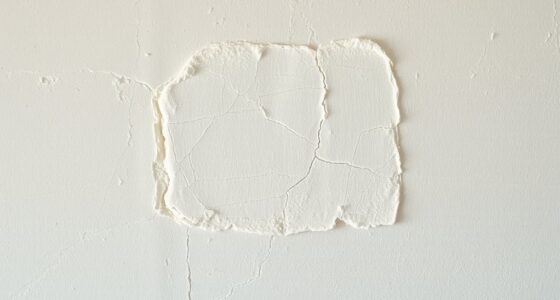Felt tiles and PET panels are excellent sustainable options to enhance your space. They effectively absorb sound, reduce noise, and improve acoustics while supporting eco-friendly practices. Made from recycled materials like wool, synthetic fibers, and plastics, they help minimize environmental impact and promote healthier indoor air quality. Their versatile designs easily fit various interior styles, and their durability ensures long-term use. If you want to explore more eco-conscious choices, there’s plenty to uncover ahead.
Key Takeaways
- Felt tiles and PET panels are made from recycled wool, synthetic fibers, and post-consumer plastics, supporting eco-friendly materials.
- These panels help reduce environmental impact by utilizing recycled content and promoting sustainable manufacturing practices.
- They contribute to healthier indoor air quality with VOC-free options, aligning with eco-conscious design goals.
- Durable and long-lasting, these panels minimize waste and reduce the need for frequent replacements.
- Their lightweight, reusable nature facilitates easy installation, customization, and environmentally responsible interior updates.

Are you looking for stylish, eco-friendly solutions to enhance your space? Felt tiles and PET panels offer an excellent way to do just that. These materials combine sustainability with functionality, making them popular choices for both residential and commercial interiors. One of the main advantages of felt tiles is their exceptional acoustic properties. When installed, they absorb sound waves effectively, reducing noise levels and creating a quieter, more comfortable environment. Whether you’re designing a cozy home office, a lively café, or a busy conference room, these panels help manage sound in a way that feels natural and unobtrusive. Their ability to dampen echoes and reverberations makes them invaluable for spaces where clarity of speech and tranquility matter most.
Beyond their acoustic benefits, felt tiles and PET panels stand out for their design versatility. They come in a wide array of colors, shapes, and textures, allowing you to customize your space with ease. Want a bold, colorful accent wall? Or perhaps a subtle, textured ceiling that blends seamlessly with your decor? These panels can be cut, arranged, and combined to suit any aesthetic, whether you prefer modern minimalism, rustic charm, or eclectic vibrancy. Their lightweight nature also simplifies installation, giving you the flexibility to update your environment without much hassle. You can even mix and match different styles and patterns to create unique visual effects that reflect your personality and taste.
Sustainability is at the heart of felt tiles and PET panels. Made from recycled materials, they minimize environmental impact while providing durable, long-lasting solutions. Felt tiles are typically crafted from recycled wool or synthetic fibers, and PET panels often utilize post-consumer plastic bottles transformed into sturdy, attractive wall coverings. Choosing these options not only supports eco-conscious practices but also contributes to healthier indoor air quality, as many felt and PET products are free from volatile organic compounds (VOCs). Plus, their durability means you won’t need frequent replacements, reducing waste over time. Additionally, their low-maintenance nature makes them an even more sustainable choice for long-term use.
Frequently Asked Questions
How Do Felt Tiles and PET Panels Compare in Sound Absorption?
You’ll find that felt tiles generally offer superior acoustic performance compared to PET panels due to their higher material density, which absorbs sound more effectively. Felt’s dense fibers trap and diffuse sound waves better, reducing noise levels. PET panels, while eco-friendly, tend to have lower density, making them slightly less effective at sound absorption. Your choice depends on how much you prioritize sound quality and sustainability for your space.
Are Felt Tiles and PET Panels Suitable for Outdoor Use?
Felt tiles and PET panels aren’t ideal for outdoor use, as only 20% of felt tiles withstand weather conditions well. They lack outdoor durability and weather resistance, making them prone to damage from moisture, UV rays, and temperature fluctuations. If you need materials for outdoor spaces, opt for specially designed weather-resistant options. Otherwise, you risk deterioration and reduced acoustic performance over time.
What Are the Maintenance Requirements for Felt Tiles and PET Panels?
You should clean felt tiles and PET panels regularly to maintain their appearance. Aim for a cleaning frequency of at least once a week, and spot clean spills or stains promptly to prevent permanent staining. Use a damp cloth or mild cleaning solution for stain removal, avoiding harsh chemicals that could damage the surface. Regular maintenance keeps these sustainable options looking fresh and prolongs their lifespan.
Can These Materials Be Recycled After Their Lifespan?
Yes, felt tiles and PET panels can be recycled after their lifespan. Recycling processes typically involve breaking down the materials to recover fibers or plastics, though availability depends on local facilities. You should consider their material durability, which affects how long they last before recycling. Proper disposal and recycling help reduce waste and support sustainability, ensuring these eco-friendly options continue to benefit the environment after their functional life ends.
Do Felt Tiles and PET Panels Contain Any Harmful Chemicals?
Did you know that over 80% of building materials contain chemicals that could impact indoor air quality? Felt tiles and PET panels generally have safe material composition, but chemical safety varies by manufacturer. Some may include adhesives or dyes with harmful chemicals, so it’s crucial to verify product labels. Always choose those certified for low emissions to guarantee a healthier indoor environment and reduce exposure to potential toxins.
Conclusion
Choosing felt tiles and PET panels champions sustainability while sparking style. By switching to these smart, sound-absorbing surfaces, you support a greener globe and gain a gorgeous, guilt-free space. Make mindful moves toward more eco-friendly, enchanting environments with materials that matter. Remember, small switches can notably shape a sustainable, stylish sanctuary. So, step confidently into a cleaner, cooler future, and let your space speak sustainably and stunningly!









